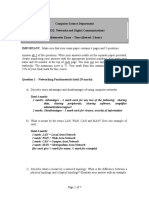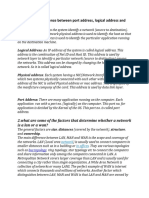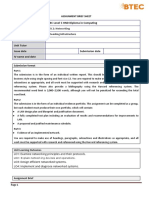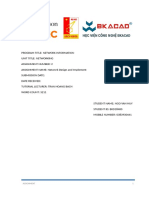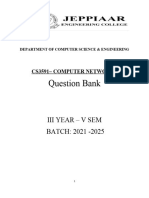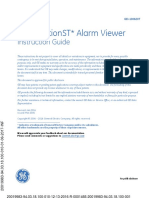Network Devices & Network Topology
Network Devices & Network Topology
Uploaded by
Aabbuu MynCopyright:
Available Formats
Network Devices & Network Topology
Network Devices & Network Topology
Uploaded by
Aabbuu MynCopyright
Available Formats
Share this document
Did you find this document useful?
Is this content inappropriate?
Copyright:
Available Formats
Network Devices & Network Topology
Network Devices & Network Topology
Uploaded by
Aabbuu MynCopyright:
Available Formats
Ring topology
.Introduction
Ring topology refers to a topology in which each computer is linked to exactly two
other computers to form a ring. The message transmission is unidirectional and
circular.This network topology is deterministic in nature, which means that each
computer is granted transmission access at a fixed time interval. All of the nodes
are linked in a closed loop. This topology is primarily based on a token-based
system, with the token traveling in a loop in only one direction.
If a token is free in a ring topology, the node can capture it, attach the data and
destination address to it, and then leave the token for communication. When this
token reaches the destination node, the receiver removes the data and frees the
token to carry the next data.
Impact of Ring topology
If a node fails, the entire network fails.
Data transmission speed is slow (each message has to go through the ring path).
It is difficult to reconfigure (we have to break the ring)
Star Topology
.Introduction
A computer network topology in which all nodes are connected to a centralized hub
is known as a star topology. The hub or switch serves as a bridge between the
nodes. Any node requesting or providing service must first communicate with the
hub.
The central device (hub or switch) has a point-to-point communication link with the
devices (the dedicated link between the devices that cannot be accessed by another
computer). Depending on the central device used, the message is then broadcast or
unicast. The hub broadcasts the message, whereas the switch unicasts it by using a
switch table. Broadcasting increases unnecessary network data traffic.
In a star topology, the hub and switch serve as servers, while the other connected
devices serve as clients. To connect a node to the central device, only one input-
output port and one cable are required. Because data does not pass through every
node in this topology, it is more secure.
Impact of Star Topology
The network will fail if the central device fails.
The network's device count is limited (due to limited input-output port in a
central device).
Mesh Topology
Mesh topology is a computer network topology in which nodes are linked together. In
other words, direct communication occurs between network nodes.
Mesh is classified into two types:
Full Mesh: Each node in the network is connected to every other node in the
network.
Partial Mesh: A network in which some nodes are not connected to every other node.
Each device in a fully connected mesh topology has a point-to-point link with every
other device in the network. If the network contains 'n' devices, then each device
has exactly '(n-1)' input-output ports and communication links. These are simplex
links, which means that data only moves in one direction. A duplex link (which
allows data to travel in both directions at the same time) can replace two simplex
links.
If we use simplex links, the number of communication links for 'n' devices is 'n(n-
1)', whereas it is 'n(n-1)/2' if we use duplex links in the mesh topology.
Impact of Mesh Topology
Extremely high cabling is required.
Implementation is expensive.
The network is difficult to install and takes up a lot of space.
Installation and upkeep are extremely difficult.
Tree Topology
Introduction
A tree topology is a computer network topology in which all nodes are connected to
the main bus cable, either directly or indirectly. Tree topology is a hybrid of the
Bus and Star topologies.
A tree topology divides the entire network into segments that can be easily managed
and maintained. In this topology, there is a main hub and all of the other sub-hubs
are linked to it.
Impact of Tree Topology
The cost of cabling and hardware is high.
Implementation is difficult.
Hub cabling is also necessary.
A large network with a tree topology is difficult to manage.
It necessitates a lot of upkeep.
The network will fail if the main bus fails.
Hybrid Topology
Introduction
A hybrid topology is a computer topology made up of two or more topologies. They
are the most commonly used in practice.
All topologies in this topology are interconnected based on their needs to form a
hybrid. All of the advantages of each topology can be combined to form an efficient
hybrid topology.
Impact of Hybrid Topology
Complex design.
Expensive to implement.
Multi-Station Access Unit(MSAL) required.
You might also like
- Interim ReportDocument3 pagesInterim ReportkomalkasatNo ratings yet
- TopologyDocument6 pagesTopologyHaruhi SuzumiyaNo ratings yet
- 2016 Question Bank Computer NetworksDocument17 pages2016 Question Bank Computer Networksaarthy100% (1)
- Key Components For A Workstation To Connect To A Network P3 Unit 9Document1 pageKey Components For A Workstation To Connect To A Network P3 Unit 9treyNo ratings yet
- Networking Mid-Semester Exam Marking Scheme - 2004-5 Semester 1Document7 pagesNetworking Mid-Semester Exam Marking Scheme - 2004-5 Semester 1abraha gebruNo ratings yet
- Computer Network 1st AssignmentDocument3 pagesComputer Network 1st AssignmentRodney AlexanderNo ratings yet
- 18CSS202J Computer Communication Lab Manual-FINAL EDITEDDocument36 pages18CSS202J Computer Communication Lab Manual-FINAL EDITEDKoushikNo ratings yet
- AL ICT m3 Logic FirstDocument5 pagesAL ICT m3 Logic FirstKanishka SeneviratneNo ratings yet
- Chapter 6-2 - Network Components (Bridges)Document7 pagesChapter 6-2 - Network Components (Bridges)Afendey ArthurNo ratings yet
- Project Synopsis On LAN ConnectionDocument15 pagesProject Synopsis On LAN ConnectionডৰাজবংশীNo ratings yet
- Data Communication AssignmentDocument4 pagesData Communication Assignmentakash chaudharyNo ratings yet
- Te CN Lab ManualDocument58 pagesTe CN Lab Manualenggeng7No ratings yet
- Data and Computer Communications: Chapter 4 - Transmission MediaDocument35 pagesData and Computer Communications: Chapter 4 - Transmission MediaRuchiNo ratings yet
- Switching: Dr. Gihan NaguibDocument24 pagesSwitching: Dr. Gihan NaguibvrkatevarapuNo ratings yet
- Different Approach of Software DesignDocument8 pagesDifferent Approach of Software Designতোর বাপNo ratings yet
- Data Communication Assignment Final PDFDocument5 pagesData Communication Assignment Final PDFFahad RuhulNo ratings yet
- Computer Network NotesDocument7 pagesComputer Network NotesAnnis ShafikaNo ratings yet
- Knowlege Exam 2006Document15 pagesKnowlege Exam 2006nuri mohammedNo ratings yet
- Samir K.C. NetworkingDocument105 pagesSamir K.C. NetworkingroodlesnepalNo ratings yet
- Qualification BTEC Level 5 HND Diploma in Computing Unit Number Assignment Title Academic Year Unit Tutor Issue Date Submission Date IV Name and DateDocument13 pagesQualification BTEC Level 5 HND Diploma in Computing Unit Number Assignment Title Academic Year Unit Tutor Issue Date Submission Date IV Name and DateNguyen Manh TaiNo ratings yet
- Unit 4 Database Design Development-2022Document6 pagesUnit 4 Database Design Development-2022Aabbuu MynNo ratings yet
- Computer Networks Assignment # 01Document3 pagesComputer Networks Assignment # 01Abdul MananNo ratings yet
- Oops ConceptsDocument8 pagesOops ConceptsManoj ManoharanNo ratings yet
- UNIT 1 AKTU Last Five Year Solutions - Computer Networks - (KCS-603)Document15 pagesUNIT 1 AKTU Last Five Year Solutions - Computer Networks - (KCS-603)mayushbbk18No ratings yet
- Switching TechniquesDocument8 pagesSwitching Techniquesnak patNo ratings yet
- Chapter 1: Introduction To Packet TracerDocument3 pagesChapter 1: Introduction To Packet Traceralieu mansarayNo ratings yet
- AdHoc NetworksDocument34 pagesAdHoc NetworksDecent Nil100% (1)
- Data Communication Lecture NoteDocument116 pagesData Communication Lecture Notelovet essampongNo ratings yet
- Source Port: 16 Bits: TCP Header FormatDocument6 pagesSource Port: 16 Bits: TCP Header Format254186No ratings yet
- Network ProtocolsDocument20 pagesNetwork ProtocolsKamesh SjNo ratings yet
- Chapter 1 - Computer Network OverviewDocument36 pagesChapter 1 - Computer Network OverviewGENENE TISENo ratings yet
- Rdbms Unit IIDocument68 pagesRdbms Unit IIrogithaNo ratings yet
- CN NotesDocument109 pagesCN Notesanujgargeya27No ratings yet
- TCP & UdpDocument29 pagesTCP & UdpMALLIKARJUN YNo ratings yet
- Network DevicesDocument5 pagesNetwork Deviceslvsaru50% (2)
- CN Unit1 8-7-10Document20 pagesCN Unit1 8-7-10nallapatiharika0% (1)
- CS8591 - CN Unit 1 PDFDocument44 pagesCS8591 - CN Unit 1 PDFMsd70% (1)
- Extra Problems On Chapter 2 (HTTP and FTP)Document10 pagesExtra Problems On Chapter 2 (HTTP and FTP)Farhan Sheikh MuhammadNo ratings yet
- UNIT 6 Hardware & Software Concepts PDFDocument9 pagesUNIT 6 Hardware & Software Concepts PDFlavanyatumuNo ratings yet
- CCN Lab 5 STPDocument7 pagesCCN Lab 5 STPShayan FatimaNo ratings yet
- Networking Assignment 2 Course HeroDocument37 pagesNetworking Assignment 2 Course Heroksav yadavNo ratings yet
- Unit-Iii: (Q) Explain Network Layer Design Issues? (2M/5M)Document28 pagesUnit-Iii: (Q) Explain Network Layer Design Issues? (2M/5M)karthik vaddiNo ratings yet
- Computer Network Module 1Document205 pagesComputer Network Module 1shakti139No ratings yet
- Transmission MediaDocument73 pagesTransmission Mediahardcore85No ratings yet
- How To Distinguish T568A and T568B of RJ45 Ethernet Cable WiringDocument4 pagesHow To Distinguish T568A and T568B of RJ45 Ethernet Cable WiringPuneet DubeyNo ratings yet
- Software Engineering Often Asked Question Answers PDFDocument54 pagesSoftware Engineering Often Asked Question Answers PDFAbdul rakib KhanNo ratings yet
- Advantages and Disadvantages of MeshDocument3 pagesAdvantages and Disadvantages of MeshRama KrishnaNo ratings yet
- CCNA1 v5 + v5.02 Final Exam Answers: LAN MAN WlanDocument37 pagesCCNA1 v5 + v5.02 Final Exam Answers: LAN MAN WlanIon CaramanNo ratings yet
- Experiment NoDocument30 pagesExperiment NoSwati Sharma0% (1)
- Physical Design of Internet of Things (IOT)Document4 pagesPhysical Design of Internet of Things (IOT)Sahil GuptaNo ratings yet
- The Cisco Three Layer Hierarchical Model PDFDocument19 pagesThe Cisco Three Layer Hierarchical Model PDFSteveih100% (1)
- Chapter 2Document12 pagesChapter 2Uk'xRoXzNo ratings yet
- 4.2.4.5 Packet Tracer - Connecting A Wired and Wireless LAN Instructions (Editado)Document5 pages4.2.4.5 Packet Tracer - Connecting A Wired and Wireless LAN Instructions (Editado)Benjamin GmNo ratings yet
- EXPERIMENT 7 Share Printer and FolderDocument7 pagesEXPERIMENT 7 Share Printer and Foldershriomom.24100% (1)
- B.tech CS S8 Client Server Computing Notes Module 1Document13 pagesB.tech CS S8 Client Server Computing Notes Module 1Jisha ShajiNo ratings yet
- Cs3591 Computer NetworksDocument32 pagesCs3591 Computer NetworksNarmatha RamasamyNo ratings yet
- Network Management System A Complete Guide - 2020 EditionFrom EverandNetwork Management System A Complete Guide - 2020 EditionRating: 5 out of 5 stars5/5 (1)
- Database Management System Technologies A Complete Guide - 2019 EditionFrom EverandDatabase Management System Technologies A Complete Guide - 2019 EditionRating: 5 out of 5 stars5/5 (1)
- Canh Bao DPC Is ProhibitedDocument3 pagesCanh Bao DPC Is ProhibitedhangkekeNo ratings yet
- Integrating The Cp210x Virtual Com Port DriverDocument10 pagesIntegrating The Cp210x Virtual Com Port Driver2saeful5No ratings yet
- DX DiagDocument28 pagesDX DiagAreeba AlNo ratings yet
- Modulation and Coding Trade-Offs: Digital CommunicationsDocument14 pagesModulation and Coding Trade-Offs: Digital CommunicationsTran Quang Thai B1708908No ratings yet
- Blindfold EQDocument4 pagesBlindfold EQmarcusolivusNo ratings yet
- Operating Systems - Interprocess Communication - SignalsDocument17 pagesOperating Systems - Interprocess Communication - SignalsAeram El HeniNo ratings yet
- Diploma (One Year) (B.Voc.) (Software Development) Semester-I Examination Computer Fundamentals-I Compulsory Paper-4Document2 pagesDiploma (One Year) (B.Voc.) (Software Development) Semester-I Examination Computer Fundamentals-I Compulsory Paper-4rinkulilhareNo ratings yet
- William Stallings Computer Organization and ArchitectureDocument18 pagesWilliam Stallings Computer Organization and ArchitectureRobson FerreiraNo ratings yet
- DOS INT 21h - DOS Function Codes: AH Description AH DescriptionDocument14 pagesDOS INT 21h - DOS Function Codes: AH Description AH DescriptionЕмир ОсманоскиNo ratings yet
- Set Up Data Exports On MaXYmos v2Document10 pagesSet Up Data Exports On MaXYmos v2dao trong nghiaNo ratings yet
- CCNA 1 Routing and Switching - Introduction To Networks Final Exam - CisacadDocument27 pagesCCNA 1 Routing and Switching - Introduction To Networks Final Exam - CisacadplayonteamNo ratings yet
- MPDR Connection GuideDocument7 pagesMPDR Connection GuideStas100% (2)
- Implementation of Cache MemoryDocument15 pagesImplementation of Cache MemoryKunj PatelNo ratings yet
- Expanding The UVM Register Model Towards Automation and Simplicity of UseDocument10 pagesExpanding The UVM Register Model Towards Automation and Simplicity of Usenvenkatesh485No ratings yet
- Pricelist LettersizeDocument3 pagesPricelist LettersizeMico de LeonNo ratings yet
- Obtaining and Activating The License Key: About Free VersionDocument4 pagesObtaining and Activating The License Key: About Free VersionEDERTREVISANNo ratings yet
- Aerohive Certified Wireless Administrator (Acwa) : Aerohive's Instructor-Led TrainingDocument552 pagesAerohive Certified Wireless Administrator (Acwa) : Aerohive's Instructor-Led TraininggicochavezNo ratings yet
- Unit1,2,3Document125 pagesUnit1,2,3anviarora0987654321No ratings yet
- Characteristics of A MicroprocessorDocument14 pagesCharacteristics of A MicroprocessorDeepanshu BansalNo ratings yet
- Workstationst Alarm Viewer: Instruction GuideDocument118 pagesWorkstationst Alarm Viewer: Instruction GuideMARIO OLIVIERINo ratings yet
- Install - Bundle Packages in UbuntuDocument4 pagesInstall - Bundle Packages in UbuntuAhmad RabieNo ratings yet
- Photography CatalogueDocument8 pagesPhotography CataloguealxxdsNo ratings yet
- Next Generation Storage Tiering With Dell Emc Isilon SmartpoolsDocument34 pagesNext Generation Storage Tiering With Dell Emc Isilon Smartpoolsfei xiaoNo ratings yet
- Oracle PaaS and IaaS Public Cloud Services Pillar Document - April 2020Document39 pagesOracle PaaS and IaaS Public Cloud Services Pillar Document - April 2020SNo ratings yet
- Cisco Security Device Manager User Guide: (Versions 2.4 and 2.5)Document23 pagesCisco Security Device Manager User Guide: (Versions 2.4 and 2.5)MaggieMoonNo ratings yet
- Code Led MatrixDocument25 pagesCode Led MatrixDanhNo ratings yet
- F2 Progression 19-20Document1 pageF2 Progression 19-20NKETCHOGUE MPATCHIE HENSCHELNo ratings yet
- Cisco VXLANDocument19 pagesCisco VXLANMalik SalahuddinNo ratings yet
- Andysah Putera Utama Siahaan - Comparison Analysis of CPU Scheduling FCFS, SJF and Round RobinDocument8 pagesAndysah Putera Utama Siahaan - Comparison Analysis of CPU Scheduling FCFS, SJF and Round RobinKen SentoriasNo ratings yet
- VSpace Server 8.1.1.5 Release Notes 150206Document4 pagesVSpace Server 8.1.1.5 Release Notes 150206Nikos PapandreouNo ratings yet




